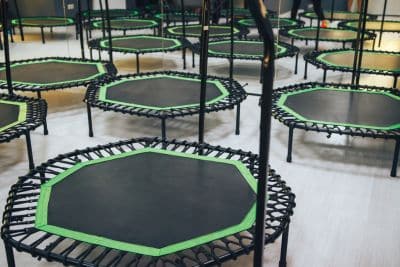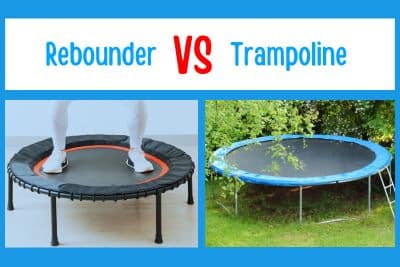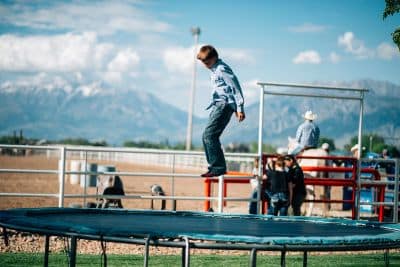Rebounders and trampolines are jumping platforms used for exercise and fun. But they differ in size, weight limit, price, and overall performance differs in many ways. So, what are the differences between rebounder vs trampoline?
A rebounder is a small indoor trampoline used for exercise and fitness, whereas a trampoline is larger, that is mainly used for outdoor activities. Rebounders are best suited for indoor and individual activities. On the other hand, trampolines are best for outdoor and group activities.
Let’s look closer for more details on the trampoline and rebounder differences so you understand clearly which one fits you best
What is a Rebounder?

A rebounder is a mini portable trampoline that is used for cardio workouts. Its key components are a small frame, tight springs, mat, and legs.
Rebounders are mainly used indoors, but you can use them outside too. They are great for year-round exercise. A good thing is that you can easily carry and store rebounder.
Rebounders are used for several purposes including-
- Balance
- Cardio and coordination training
- Strength-building exercises
- Low-impact exercises like dancing, jumping, or running
What is a Trampoline?
A trampoline is a larger jumping equipment consisting of a metal frame, coiled springs, a jump bed, legs, and more. They are suitable for recreational and gymnastic activities like jumping, exercising, and acrobatics.
For this reason, you will mostly find them in backyards, and trampoline parks. Also, some trampolines have safety features like nets and paddings to reduce injury.
Differences Between Trampoline and Rebounder
A rebounder is a mini version of a trampoline, So, most of their features are closely related. Each of them has some perks for its uniqueness. Now, I’ll break down their differences below.
1. Size
Compared to a trampoline, a rebounder is smaller in size. Due to their small size, rebounders are easy to set up, take down, store, and transport. Usually, rebounders come in 3 to 5 ft sizes.
On the other hand, you need a large backyard to install a trampoline. Outdoor trampoline size may vary from 5 ft to 20 ft and even larger.
2. Shape and Style
Both trampolines and rebounders come in different shapes. But trampolines are available in more versatile shapes including circular, oval, square, rectangular, hexagonal, and octagonal. Whereas rebounders come in mainly round shapes.
3. Weight Capacity
Depending on the brand and model, the weight limit of the rebounder may vary. On average, they can hold 200 lbs jumper’s weight, but some powerful rebounders can support up to 400 or 500 pounds.
In contrast, small trampolines can support 100 pounds of weight. The average weight capacity of larger models is 300 lb, but high-end ones can take up to 500 and even 1000 pounds.
4. Price

Rebounder prices vary depending on brand and quality. You can get one for as low as 50 bucks, and the price goes as high as 1000 bucks. Their average price is $100.
In comparison, the average price of outdoor trampolines is $300. But the top-quality models’ price may go as high as 3000 bucks and even more.
5. Safety
The rebounder is low height platform that tends to lower injury rates. Compared to that, a trampoline is a larger jumping equipment that has numerous potential hazards like spring caught, falling on the ground or frame, etc.
But nowadays most trampolines have safety nets and foam padding on springs to reduce injury rates. To increase safety on rebounders, some models include handles for better hand support.
6. Durability
Trampolines are made of heavy-duty materials as they are exposed to the environment. Usually, trampolines last 5 to 10 years and even more. On the other hand, rebounders last between 1 to 2 years, but some top-notch ones survive several years.
7. Care and Maintenance
Rebounders are comparatively easy to care for and maintain. But trampolines need some extra care and protection.
As trampolines are exposed to harsh weather so you may need some extra accessories there such as-
- Wind stakes to stop blowing away
- Weather cover for rain, winter, sun, and dust protection
8. Space Matters
Choose a trampoline vs a rebounder depending on the space available. Consider a rebounder if you are in a limited space. It will come in handy if you don’t have a yard, live in an apartment, or don’t want to keep shifting when it rains or snows.
High-quality bungee rebounders are good, as they give users a soft bounce. Of course, without disturbing your neighbors.
A standard trampoline will work well if you have enough space. It would be best if you had a piece of equipment your whole family could enjoy.
9. Portability
This is another key difference between rebounder and trampoline. As rebounders are small in size so you can easily transport and store them. Moreover, some of them are foldable.
On the other hand, trampolines aren’t portable as rebounders due to their heaviness and large size. But you can transport them using some technique.
10. Use

Rebounders are a great choice for any age, even the elderly. You can use them for a lung-strengthening workout despite having a knee or back problem.
But a trampoline is better if you have children or teenagers at home. Round trampolines are the best since they have a soft and even bounce compared to rectangular shapes.
You may opt for a large trampoline as it will serve you longer since your children will grow with it and even adults can also use it.
An outdoor trampoline is used for recreation and exercise reasons. But a rebounder is better if you want to do some basic exercises like jumping the place, walking, and bouncing for fitness.
Again, if you will be doing flips, or other advanced jumping tricks, a large trampoline will be ideal.
11. Fun and Exercise Options
The mini trampoline rebounders are a great option if you want to jog, bounce or walk during your workout. Also, some come with various exercise routines and basic workout videos.
Outdoor trampolines encourage play. Large pieces have extra accessories, like basketball sets, bounce boards, and tent attachments for additional fun.
Pros and Cons of Rebounder
Advantages of a Rebounder
- Can be used indoors and outside
- Easy to carry and store
- Good for low-impact exercises
- Easy care and maintenance
Disadvantages of a Rebounder
- Can lead to injuries if used incorrectly
- Some high-end models’ can be expensive
Pros and Cons of Trampoline
Advantages of Trampolines
- Good for exercise and fun
- You can use it for a variety of exercises
- Available in different sizes and shapes
Disadvantages of trampolines
- They need large spaces
- You cannot use it in bad weather conditions like heavy rains
Rebounder Vs Trampoline Comparison Table
After discussing the differences between trampolines and rebounders let’s recap their comparison in the following table.
| Comparison Topic | Trampoline | Rebounder |
| Size | 5 ft to 20 ft and ever larger | 3 ft to 5 ft |
| Shape | Round, rectangular, oval, square, hexagonal, octagonal, etc | Mainly round |
| Average weight capacity (lbs) | 200 | 300 |
| Where to use | Outdoor | Indoor |
| Purpose to use | Recreation and exercise | Fitness |
| Easy to carry and hide | Yes | No |
| Durability (years) | 5 to 10 years | 1 to 2 years |
| Average price | $300 | $100 |
Frequently Asked Questions
1) Is rebounder and mini trampoline same?
Ans: Mini trampolines are designed for indoor purposes. In this sense, all rebounders are mini trampolines, but all mini trampolines aren’t rebounders.
They differ in several fields, such as mini trampolines used for recreation and exercise, but rebounders are only for fitness. Anyone can use mini trampolines, but rebounders are basically designed for fitness enthusiasts.
Rebounders are low-impact and silent exercise tools as most of them use bungee cords, whereas most mini-trampolines use springs.
2) What are the differences between indoor vs outdoor trampoline?
Ans: Outdoor trampolines are made of sturdier material compared to the indoor models. Outdoor tramps are available in numerous sizes and shapes, have hefty weight capacity, allow doing lots of tricks, etc. On the other hand, indoor trampolines are cheaper, space saver, easy to carry and store, and more.
Conclusion
A rebounder is good for rehabilitation or fitness purposes. It’s smaller with a lower weight limit than a traditional trampoline. But a trampoline is larger and designed for fun and recreation, like acrobatics and jumping activities.
Both rebounders and trampolines will give you high-energy and low-impact workouts. Whether you choose a rebounder or a trampoline, go for quality equipment that supports the weight of the users.

Rebecca is a fitness nerd and mother. She was inspired to get into the world of trampolining and rebounding by her husband Robert, who is a well-respected trainer and expert in the field. Now she instructs children, mothers, and teens the basic trampolining and rebounding tricks.
Rebecca is also a passionate blogger, sharing her knowledge and experiences with others in the hope of encouraging them to give trampolining and rebounding a try.
